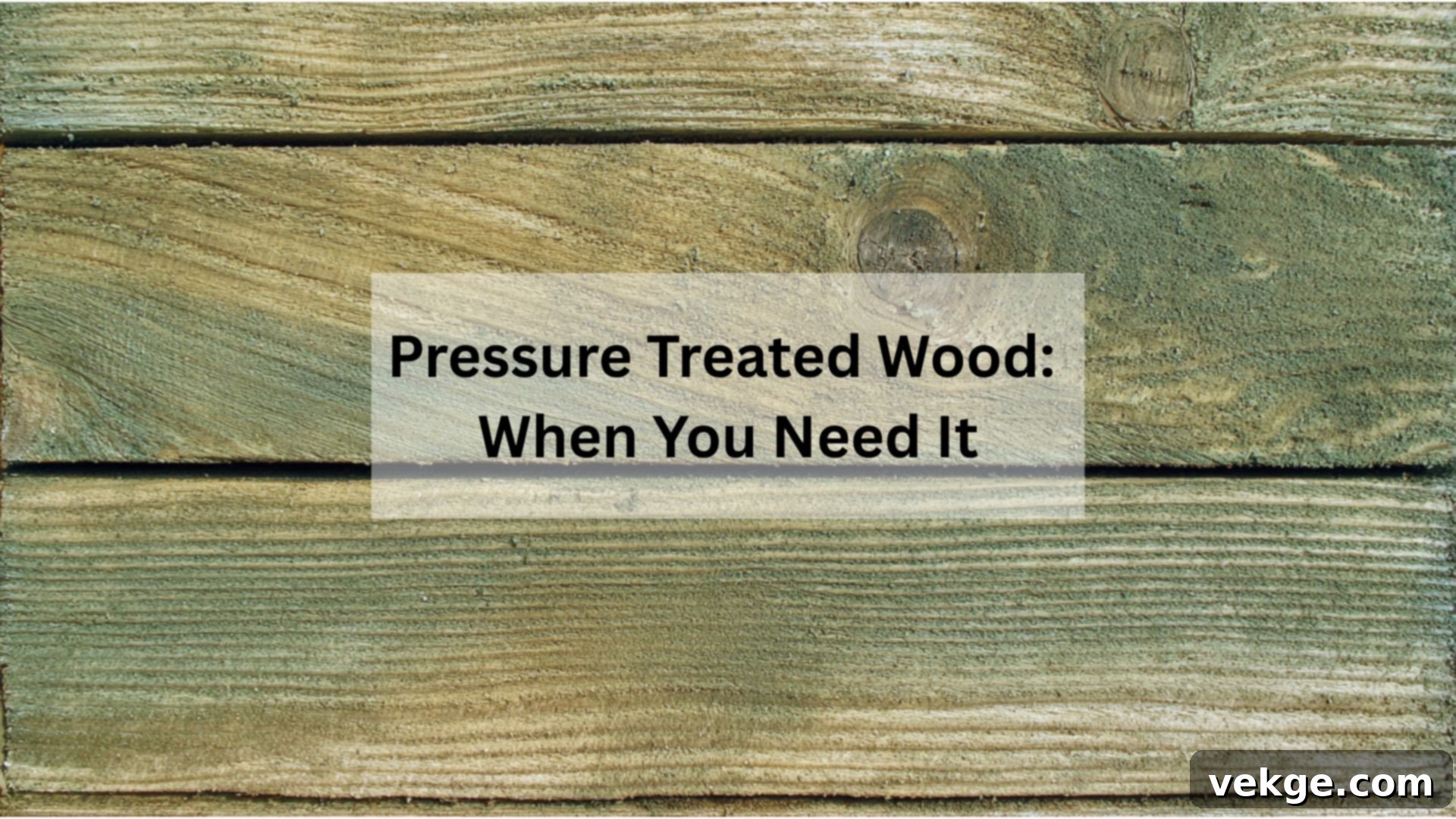The Ultimate Guide: When to Use Pressure-Treated Wood for Lasting Outdoor Projects
Embarking on an outdoor construction project? You’ve likely considered various materials, but one stands out for its resilience and longevity: pressure-treated wood. This specialized lumber is an indispensable material in modern construction, particularly for structures exposed to the elements, vastly outperforming untreated alternatives in terms of durability and lifespan.
From robust decks and sturdy fences to intricate pergolas and essential ground-level supports, pressure-treated wood is the go-to choice for any application demanding extra protection against nature’s harshest challenges. Its unique treatment process imbues it with an exceptional ability to resist decay, fungal rot, and the relentless assault of wood-boring insects, which are notorious for devastating regular lumber.
The secret lies in its manufacturing: protective chemicals are driven deep into every single wood fiber under high pressure. This creates an impenetrable shield, safeguarding the wood against moisture damage, the onset of rot, and the persistent threat of pests. Understanding precisely when and where to employ pressure-treated wood is not just about building structures that endure; it’s a smart investment that protects your hard-earned money and prevents costly future repairs.
Pressure-Treated Wood vs. Regular Wood: A Durability Showdown
At first glance, regular, untreated wood might appear perfectly suitable for your outdoor endeavors. It’s often more affordable upfront and possesses a natural aesthetic. However, its inherent vulnerabilities become painfully clear when exposed to the great outdoors. Rain, snow, humidity, and general moisture quickly penetrate untreated lumber, initiating the irreversible processes of rot and decay. Furthermore, common pests like termites and carpenter ants find regular wood an irresistible food source, leading to structural compromise and significant damage.
In stark contrast, pressure-treated wood undergoes a specialized chemical treatment process. This isn’t just a surface application; the chemicals are forced deep into the wood’s cellular structure, saturating every fiber. This profound penetration creates a lasting barrier that actively prevents rot and decay before they can even begin. It also makes the wood highly unpalatable and toxic to insects, effectively keeping them at bay. The result? Your deck, fence, or any outdoor structure will maintain its structural integrity and aesthetic appeal for many more years, often decades, compared to its untreated counterpart.
Consider the long-term financial implications. While regular wood might require replacement or extensive repairs every few years, pressure-treated lumber can easily last for twenty years or more with proper maintenance. This translates to substantial savings not just on replacement materials, but also on the labor and time you would otherwise spend fixing rotted boards, battling insect infestations, or completely rebuilding structures. Opting for treated wood is choosing peace of mind and enduring value.
Beyond resistance to biological threats, the treatment process also enhances the wood’s overall stability against fluctuating weather conditions. Regular wood is prone to warping, twisting, and cracking as it repeatedly absorbs and releases moisture. Pressure-treated lumber, however, exhibits greater dimensional stability, remaining more consistent and reliable even through cycles of wet and dry weather, ensuring your outdoor projects stand firm and true for their intended lifespan.
When to Use Pressure-Treated Wood: Essential Applications
Certain construction scenarios unequivocally demand the superior protection offered by pressure-treated wood. These are situations where regular lumber would quickly succumb to environmental stressors, leading to premature failure. Understanding these critical applications ensures the longevity and safety of your outdoor constructions, where constant moisture, direct ground contact, or harsh environmental conditions are unavoidable.
1. Outdoor Projects Exposed to Constant Moisture
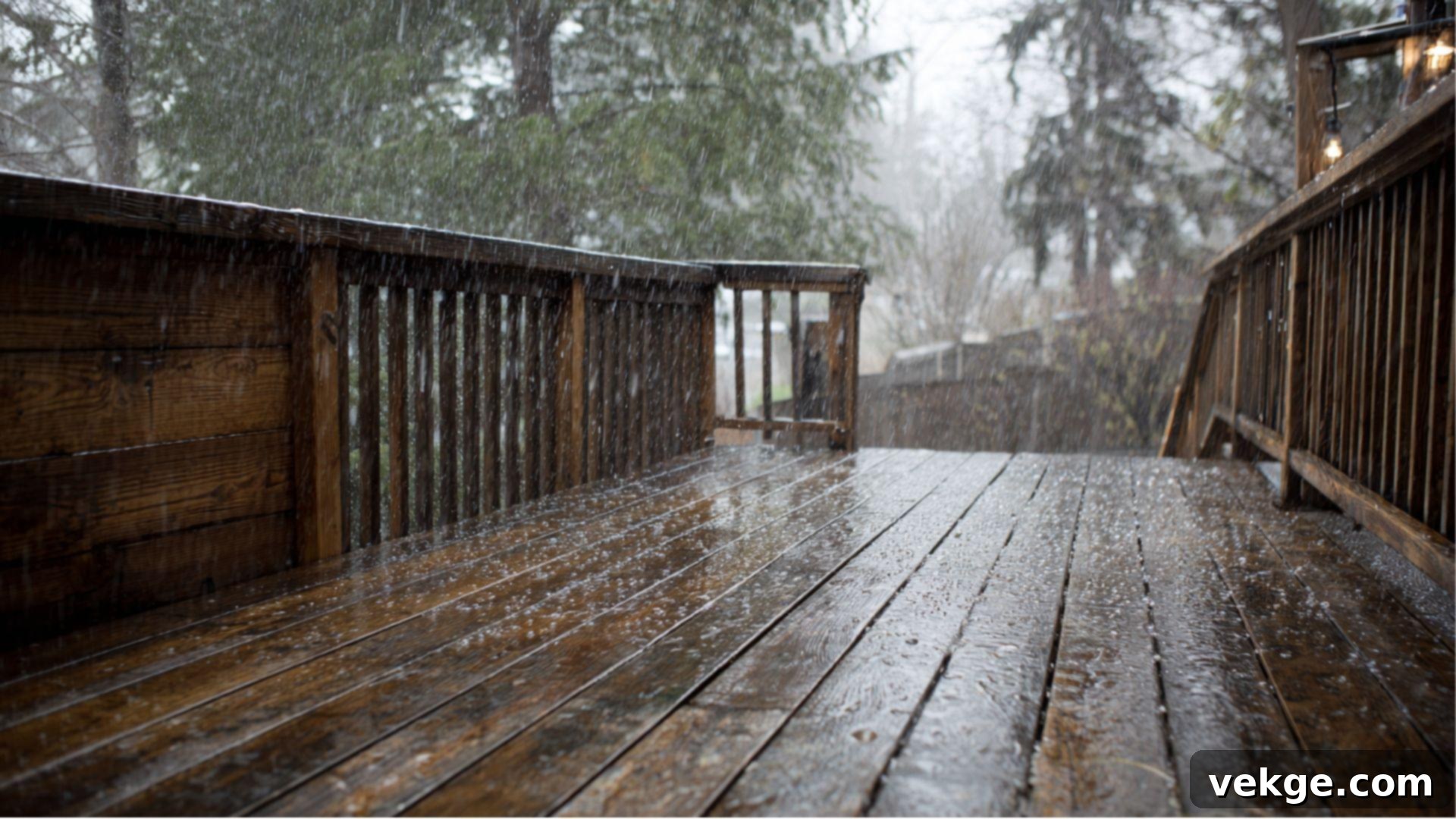
Your outdoor structures are perpetually at the mercy of the elements. A deck, for instance, endures daily exposure to rain, snow, morning dew, and the relentless spray from garden sprinklers. Fences face similar, if not identical, moisture challenges. These constant cycles of wetting and drying create an ideal breeding ground for fungi and bacteria that initiate rot in untreated wood, leading to rapid deterioration of its strength and appearance.
Landscape features such as garden borders, pergolas, and outdoor furniture also regularly get soaked during watering, heavy rainfall, or even high humidity. Pressure-treated lumber is engineered to withstand this persistent moisture without breaking down. Regular wood would quickly absorb this moisture, swell, crack, and begin to rot within just a few seasons, demanding costly replacement much sooner than anticipated.
2. Ground-Level Construction and Direct Soil Contact
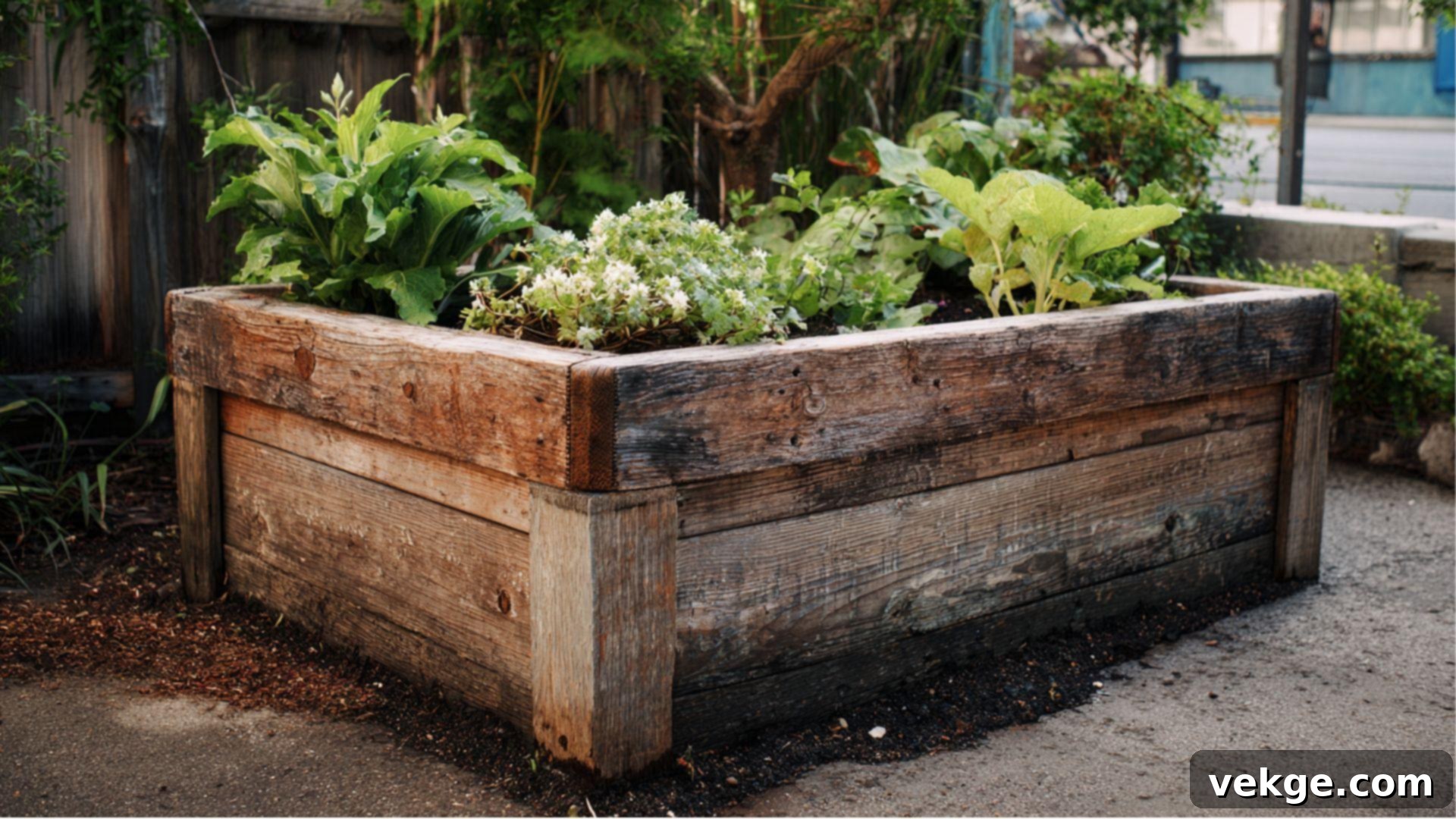
Any wood structure that comes into direct contact with the ground faces an even more aggressive set of threats. Garden beds, raised planters, and fence posts are embedded in or sit directly on damp soil, which rarely, if ever, dries out completely. Retaining walls are constantly pressed against wet earth, creating perfect, nutrient-rich conditions for rapid wood decay and the proliferation of soil-dwelling pests.
Ground moisture actively wicks or seeps up into regular lumber through capillary action, causing accelerated decay from the bottom upwards. This constant saturation provides an ideal environment for microorganisms and insects that thrive in damp soil. Pressure-treated wood, with its deeply embedded preservatives, effectively resists this persistent ground moisture and the biological activity within the soil. It remains stable and structurally sound for many years, ensuring your garden structures maintain their aesthetic appeal and functional integrity for a significantly longer duration.
3. Areas Near Water or Constantly Humid Conditions

Structures situated near bodies of water, such as lakes, rivers, or swimming pools, face extreme and continuous moisture exposure. Docks and piers are perpetually splashed by water, remaining damp for most of their existence. Boat lifts, waterside gazebos, and even pool surrounds contend with similar wet and humid conditions that regular wood simply cannot endure long-term. The synergistic combination of constant water exposure and high atmospheric humidity creates one of the most hostile environments possible for untreated lumber, leading to swift degradation and structural failure.
For these demanding applications, pressure-treated wood is not merely an option, but a necessity. Its enhanced resistance allows it to stand up to these harsh, wet conditions without succumbing to rot, mildew, or premature disintegration. Investing in pressure-treated lumber for your waterfront projects provides the critical extra protection required for these structures to survive and thrive for decades.
4. Environments Prone to Insect Infestation
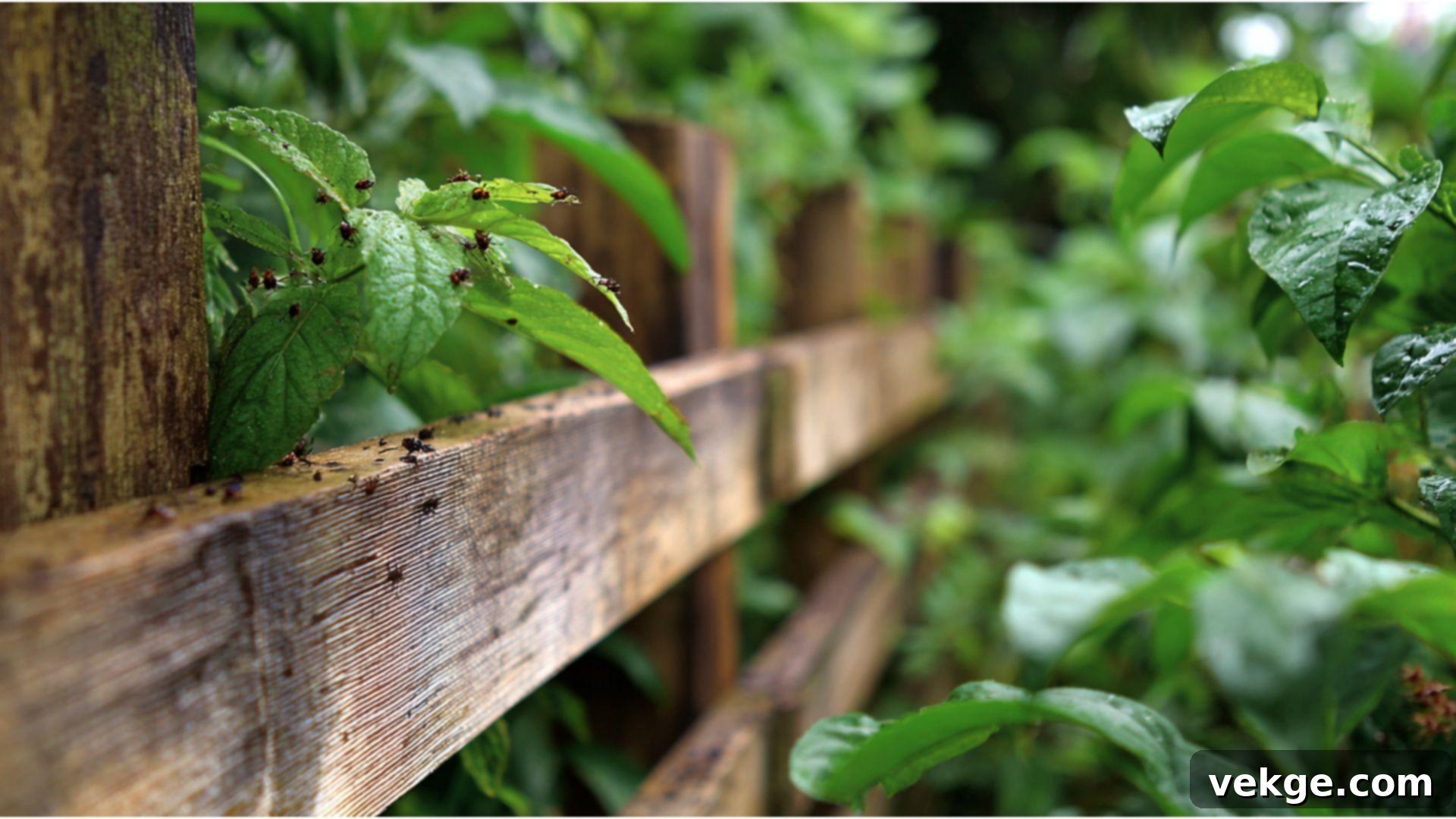
In many regions, particularly those with warm and humid climates, wood-destroying insects pose a significant threat to outdoor wooden structures. Termites, carpenter ants, and various types of beetles view regular wood as an abundant food source. Wooden fences in bug-heavy areas, garden sheds, or any outdoor structure can quickly become targets for these pests, which can cause extensive internal damage before any external signs become visible, compromising structural integrity.
Pressure-treated lumber contains specific chemicals designed to deter and kill these destructive insects. The preservatives permeate the wood fibers, making the material unpalatable and toxic to pests. This built-in defense mechanism means you won’t have to constantly worry about termites tunneling through your deck supports or carpenter ants excavating galleries in your pergola. It ensures your hard work and investment are protected from the insidious damage wrought by wood-eating pests.
5. Landscape Features Exposed to All Elements
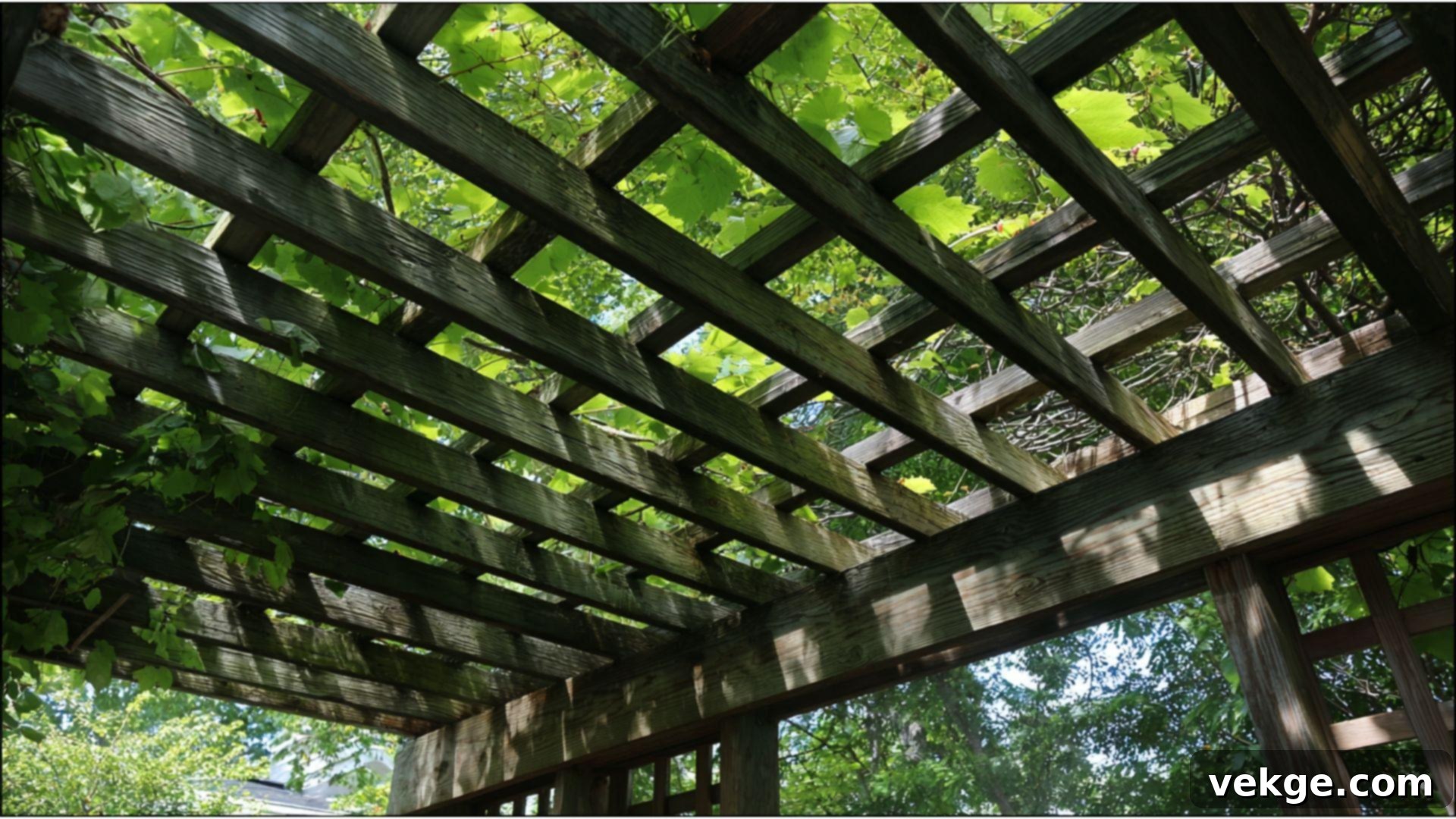
Landscape features like arbors, trellises, garden benches, and decorative bridges are continuously subjected to a comprehensive barrage of environmental elements throughout the seasons. They receive moisture from above (rain, snow) and often have parts in direct or indirect contact with moist soil. Beyond moisture, these structures also contend with direct sunlight (UV radiation), significant temperature fluctuations, and constant wind exposure.
Environmental elements such as strong winds can cause abrasion and exacerbate drying, leading to cracking. UV rays degrade the lignin in untreated wood, causing it to gray and become brittle over time. Temperature changes lead to expansion and contraction, further stressing the wood fibers. Pressure-treated wood is specifically formulated to handle this multifaceted assault. Its enhanced durability and resistance allow your landscape features to maintain their attractive appearance and structural functionality, remaining beautiful and robust focal points in your garden for many years to come.
Pressure-Treated Wood: Benefits and Drawbacks Uncovered
While the advantages of pressure-treated wood are compelling for outdoor applications, it’s also important to consider its potential drawbacks. A balanced understanding of both the pros and cons will empower you to make an informed decision, ensuring it’s indeed the optimal material for your specific project needs.
| Pros | Cons |
|---|---|
| Exceptional Durability and Longevity: Resists rot, decay, and insect infestation for decades. | Chemical Concerns: Preservatives can be harmful if not handled properly; old CCA-treated wood has disposal restrictions. |
| Superior Moisture Resistance: Ideal for outdoor use and applications in damp or wet environments. | Higher Initial Cost: Generally more expensive per board foot than untreated lumber. |
| Effective Pest Protection: Actively deters termites, carpenter ants, and other wood-destroying insects. | Requires Maintenance: Regular sealing and cleaning are still necessary to preserve appearance and further protect. |
| Versatile for Outdoor Projects: Perfect for decks, fences, pergolas, playground structures, and landscaping. | Potential for Warping or Cracking: While more stable, extreme weather can still cause some movement over time. |
| Enhanced Structural Stability: Contributes to the strength and integrity of outdoor constructions. | Distinctive Greenish Tint: Freshly treated wood has a characteristic hue, which may require staining or painting for aesthetic uniformity. |
Delving deeper, the “Cons” warrant additional attention. The chemicals used in modern pressure treatment (like ACQ or CA) are less toxic than older versions (like CCA), but proper handling, cutting, and disposal procedures are still crucial. Always wear gloves, masks, and eye protection, and never burn treated wood. The initial cost, while higher, is often offset by the greatly extended lifespan and reduced maintenance over time. While the greenish tint fades to a grayish tone over time, staining or painting can be done after the wood has thoroughly dried (usually 6-12 months) to achieve a desired aesthetic. Despite its enhanced stability, like all wood, it can still experience some movement, particularly if not properly dried or maintained.
Alternative Wood Options for Your Projects
While pressure-treated wood offers unparalleled protection for challenging outdoor scenarios, it’s not always the only or best choice for every project. A variety of natural and engineered wood alternatives exist, each with unique properties that can be equally effective and sometimes more suitable for specific building situations, potentially offering different aesthetics or cost advantages.
- Cedar: Known for its aromatic qualities, cedar naturally possesses oils that make it highly resistant to insects and moisture. This inherent durability, coupled with its beautiful reddish-brown hue, makes it an excellent choice for outdoor furniture, garden planters, siding, and decking where a natural, chemical-free option is preferred.
- Redwood: Similar to cedar, redwood boasts natural resistance to both rot and insects due to its high tannin content, requiring no chemical treatment. It’s often chosen for premium decks, fences, and outdoor structures where its rich, deep color and exceptional durability are highly valued, though it can be more expensive.
- Teak: Renowned for its extraordinary density and high oil content, teak handles water remarkably well. This makes it a premium choice for marine applications, boat building, and high-end outdoor furniture where exposure to water is constant and durability is paramount, justifying its significantly higher cost.
- Cypress: Often found in the southern United States, cypress wood contains a natural preservative called cypressene, giving it good resistance to decay and insects, especially when heartwood is used. It’s suitable for various outdoor applications, including siding, decking, and docks.
- Regular Pine and Oak: While generally unsuitable for direct ground contact or constant outdoor exposure without treatment, these woods are excellent choices for indoor construction, furniture, and projects where they are protected from the elements. They offer beautiful results at lower prices and are readily available.
- Composite Materials: Engineered from a blend of wood fibers and recycled plastics, composite decking and siding materials offer exceptional durability, minimal maintenance requirements (no sealing or staining needed), and resistance to rot, insects, and splintering. They represent a long-lasting, eco-friendly alternative for decks and other outdoor structures, though their initial cost can be higher than pressure-treated wood.
Carefully considering these alternatives can not only help you save money but also achieve specific aesthetic goals while still providing the strength and longevity your project demands. Always align your wood type selection with your specific project requirements, budget, and desired level of maintenance.
Essential Tips for Maintaining Pressure-Treated Wood
Even with its inherent resistance, pressure-treated wood benefits significantly from a simple, regular maintenance routine to ensure it remains in top condition for decades. Proper care will not only extend the life of your investment but also preserve its appearance and structural integrity against the ongoing assault of weather and time.
- Regular Cleaning: At least once every month, sweep away leaves, dirt, and any accumulated debris from your wood surfaces. This prevents moisture from being trapped against the wood, which can lead to mildew growth and premature degradation of the surface. For stubborn stains or grime, wash the surface with a mild soap and water solution using a soft brush or a low-pressure power washer (being careful not to damage the wood fibers).
- Apply a High-Quality Sealer: To enhance moisture protection and help prevent UV damage, apply a water repellent wood sealer or stain every 2-3 years. This step is crucial. A good sealer will minimize water absorption, reduce the likelihood of warping, cracking, and splitting, and help maintain the wood’s original color or allow you to change its hue. Ensure the wood is thoroughly dry before applying any finish.
- Inspect for Damage: Periodically inspect your pressure-treated wood structures for any signs of wear or damage. Look for soft, spongy spots that might indicate the beginnings of rot, small holes that could signal insect activity, or any loose fasteners. Addressing these issues promptly can prevent them from escalating into major problems.
- Ensure Good Drainage: Make sure water can drain away from your wooden structures. Avoid planting vegetation too close to posts or decking that would keep the wood constantly damp. Good air circulation is key to keeping wood dry and healthy.
By following this simple, yet effective, routine, you can significantly prolong the life and beauty of your pressure-treated wood projects. This basic care regime protects your outdoor structures from environmental damage, ensuring they remain both functional and aesthetically pleasing for many years to come.
Wrapping It Up: Making the Right Wood Choice
You now possess a comprehensive understanding of when and why to strategically use pressure-treated wood to effectively combat the relentless forces of decay, rot, and insect attacks. I strongly encourage you to prioritize this exceptionally tough and durable lumber for any outdoor project that will regularly face significant moisture exposure, direct ground contact, or the pervasive threat of wood-destroying pests.
By making this informed choice, your outdoor structures – be it a grand deck, a functional fence, or essential landscaping elements – will undoubtedly thank you. They will stand strong, maintain their structural integrity, and retain their aesthetic appeal for many years, offering lasting enjoyment and minimal hassle.
If you’re embarking on a particularly large or complex outdoor construction endeavor, or if you find yourself uncertain about the ideal wood choices for your specific climate and project scope, I highly recommend consulting with experienced construction professionals or local lumber experts. Their invaluable guidance can help steer you toward the perfect lumber type tailored to your unique needs and local environmental conditions.
Remember, while pressure-treated wood might represent a slightly higher upfront investment, this initial expenditure is a wise one. It consistently saves you countless headaches, significant repair costs, and precious time in the long run. It is an investment in durability, peace of mind, and the enduring beauty of your outdoor living spaces.
Are you ready to build something truly amazing and built to last? Share your exciting project ideas and plans in the comments below!
